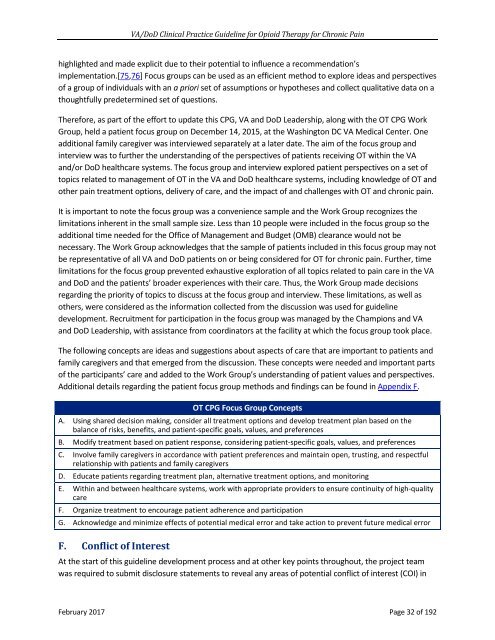VA/DoD CLINICAL PRACTICE GUIDELINE FOR OPIOID THERAPY FOR CHRONIC PAIN
2lfFhbO
2lfFhbO
Create successful ePaper yourself
Turn your PDF publications into a flip-book with our unique Google optimized e-Paper software.
<strong>VA</strong>/<strong>DoD</strong> Clinical Practice Guideline for Opioid Therapy for Chronic Pain<br />
highlighted and made explicit due to their potential to influence a recommendation’s<br />
implementation.[75,76] Focus groups can be used as an efficient method to explore ideas and perspectives<br />
of a group of individuals with an a priori set of assumptions or hypotheses and collect qualitative data on a<br />
thoughtfully predetermined set of questions.<br />
Therefore, as part of the effort to update this CPG, <strong>VA</strong> and <strong>DoD</strong> Leadership, along with the OT CPG Work<br />
Group, held a patient focus group on December 14, 2015, at the Washington DC <strong>VA</strong> Medical Center. One<br />
additional family caregiver was interviewed separately at a later date. The aim of the focus group and<br />
interview was to further the understanding of the perspectives of patients receiving OT within the <strong>VA</strong><br />
and/or <strong>DoD</strong> healthcare systems. The focus group and interview explored patient perspectives on a set of<br />
topics related to management of OT in the <strong>VA</strong> and <strong>DoD</strong> healthcare systems, including knowledge of OT and<br />
other pain treatment options, delivery of care, and the impact of and challenges with OT and chronic pain.<br />
It is important to note the focus group was a convenience sample and the Work Group recognizes the<br />
limitations inherent in the small sample size. Less than 10 people were included in the focus group so the<br />
additional time needed for the Office of Management and Budget (OMB) clearance would not be<br />
necessary. The Work Group acknowledges that the sample of patients included in this focus group may not<br />
be representative of all <strong>VA</strong> and <strong>DoD</strong> patients on or being considered for OT for chronic pain. Further, time<br />
limitations for the focus group prevented exhaustive exploration of all topics related to pain care in the <strong>VA</strong><br />
and <strong>DoD</strong> and the patients’ broader experiences with their care. Thus, the Work Group made decisions<br />
regarding the priority of topics to discuss at the focus group and interview. These limitations, as well as<br />
others, were considered as the information collected from the discussion was used for guideline<br />
development. Recruitment for participation in the focus group was managed by the Champions and <strong>VA</strong><br />
and <strong>DoD</strong> Leadership, with assistance from coordinators at the facility at which the focus group took place.<br />
The following concepts are ideas and suggestions about aspects of care that are important to patients and<br />
family caregivers and that emerged from the discussion. These concepts were needed and important parts<br />
of the participants’ care and added to the Work Group’s understanding of patient values and perspectives.<br />
Additional details regarding the patient focus group methods and findings can be found in Appendix F.<br />
OT CPG Focus Group Concepts<br />
A. Using shared decision making, consider all treatment options and develop treatment plan based on the<br />
balance of risks, benefits, and patient-specific goals, values, and preferences<br />
B. Modify treatment based on patient response, considering patient-specific goals, values, and preferences<br />
C. Involve family caregivers in accordance with patient preferences and maintain open, trusting, and respectful<br />
relationship with patients and family caregivers<br />
D. Educate patients regarding treatment plan, alternative treatment options, and monitoring<br />
E. Within and between healthcare systems, work with appropriate providers to ensure continuity of high-quality<br />
care<br />
F. Organize treatment to encourage patient adherence and participation<br />
G. Acknowledge and minimize effects of potential medical error and take action to prevent future medical error<br />
F. Conflict of Interest<br />
At the start of this guideline development process and at other key points throughout, the project team<br />
was required to submit disclosure statements to reveal any areas of potential conflict of interest (COI) in<br />
February 2017 Page 32 of 192


